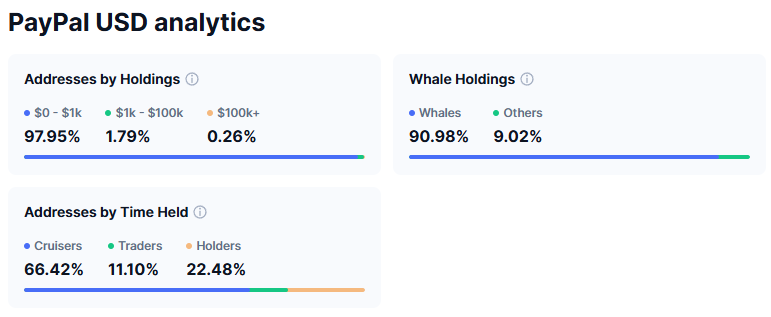-
PayPal’s PYUSD stablecoin has experienced significant growth, doubling its market cap since January 2025 and nearing the $1 billion mark amid increasing demand and regulatory clearance.
-
Despite this growth, concerns persist as over 90% of PYUSD’s supply is concentrated in whale wallets, raising questions about liquidity and decentralization within the stablecoin ecosystem.
-
The SEC’s closure of its investigation into PYUSD, coupled with PayPal’s introduction of a 3.7% annual yield on the stablecoin, highlights a growing trend toward yield-bearing stablecoins in 2025.
PayPal’s PYUSD stablecoin nears $1 billion market cap, driven by SEC clearance and yield offerings, yet whale dominance raises liquidity concerns in the stablecoin market.
PYUSD Market Cap Doubles Since Early 2025 Amid Growing Stablecoin Demand
Since its launch in Q3 2023, PayPal’s PYUSD stablecoin initially faced adoption challenges, with its market capitalization declining sharply. However, the landscape shifted in 2025 as investor confidence in stablecoins strengthened, and demand surged. According to COINOTAG, PYUSD’s market cap reached approximately $984 million by June 2025, nearly doubling from $490 million at the start of the year. This resurgence positions PYUSD to potentially surpass its previous peak of $1 billion recorded in August 2024.

Data from Token Terminal further corroborates this growth, showing a rising circulating supply of PYUSD across both Ethereum and Solana blockchains. This expansion aligns with PayPal’s strategic push into decentralized finance (DeFi), signaling a broader ambition to integrate traditional financial services with blockchain technology. Token Terminal analysts suggest that PYUSD’s market cap could experience up to a tenfold increase if current trends continue.
“PayPal’s PYUSD hits $1 billion in outstanding supply ~2 years from launch. How will it take to scale from $1 to $10 billion?” Token Terminal commented, emphasizing the stablecoin’s growth potential.
Regulatory clarity has also played a pivotal role. The US Securities and Exchange Commission (SEC) recently closed its investigation into PYUSD, alleviating regulatory uncertainties that had previously hindered investor confidence. Concurrently, PayPal has entered the competitive yield-bearing stablecoin market by offering a 3.7% annual return on PYUSD holdings. This move taps into a growing segment, as the total market cap for yield-bearing stablecoins surpassed $10 billion in 2025, according to COINOTAG.
Concentration of PYUSD Supply Highlights Liquidity and Decentralization Concerns
While PYUSD’s market cap growth is promising, the distribution of its supply raises critical concerns about market liquidity and decentralization. Analysis from CoinMarketCap reveals that whale wallets—those holding more than 1% of the total supply—control nearly 91% of PYUSD tokens. Dune Analytics further identifies that the top five wallets alone hold over $820 million, accounting for more than 80% of the circulating supply.

This pattern of supply concentration is not unique to PYUSD. The newly launched USD1 stablecoin by World Liberty Financial exhibits similar dynamics, with over 50% of its liquidity concentrated in just three wallets, as reported by Kaiko. Such concentration suggests that much of the stablecoin supply remains within developer or institutional control rather than widespread user adoption, which could impact market stability and genuine demand signals.
Despite these challenges, policymakers remain optimistic about the stablecoin sector’s future. US Treasury Secretary Scott Bessent recently projected that USD-backed stablecoins could exceed a $2 trillion market cap by 2028, underscoring the asset class’s growing significance. Additionally, the US Senate’s passage of the GENIUS Act reflects bipartisan support for regulatory frameworks aimed at fostering innovation while ensuring market integrity.
Conclusion
PayPal’s PYUSD stablecoin has demonstrated notable recovery and growth in 2025, buoyed by regulatory clarity and competitive yield offerings. However, the heavy concentration of supply in whale wallets poses ongoing concerns regarding liquidity and decentralization, which are critical for the stablecoin’s long-term viability. As the stablecoin market evolves, balancing growth with broader adoption and regulatory oversight will be essential to sustain investor confidence and market stability.





